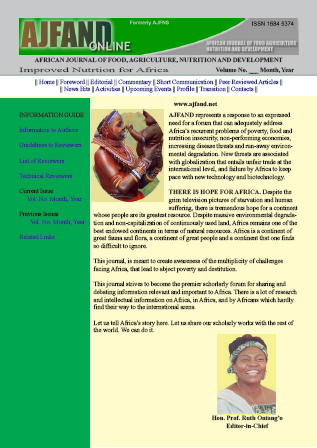
|
African Journal of Food, Agriculture, Nutrition and Development
Rural Outreach Program
ISSN: 1684-5358
EISSN: 1684-5358
Vol. 17, No. 4, 2017, pp. 12837-12853
|
 Bioline Code: nd17098
Bioline Code: nd17098
Full paper language: English
Document type: Research Article
Document available free of charge
|
|
|
African Journal of Food, Agriculture, Nutrition and Development, Vol. 17, No. 4, 2017, pp. 12837-12853
| en |
UNDERSTANDING PATHWAYS TO BETTER NUTRITION AT DISTRICT LEVEL: LESSONS FROM UGANDA
Agaba, E; Ghosh, S & Griffiths, J
Abstract
For countries looking to implement multisectoral nutrition plans, it is critical to
understand what works and how programs should be delivered and scaled-up in each
context. Programs can learn from each other on how to adapt to new information,
evidence and events related to scaling-up and district stakeholders can play important
roles in implementation of this multisectoral plan. As part of "Pathways-to-Better
Nutrition" (PBN) case study conducted by USAID/SPRING Project, this research set out
to explore district leaders’ perceptions of the nutrition situation, programs and
opportunities for integration. Qualitative data were collected through key-informant
interviews and focus group discussions. Thirty-five district and local leaders belonging
to district and sub-county multisectoral nutrition committees in Kisoro and Lira were
interviewed. Grounded Theory Approach was used to identify themes for coding and key
domains included: learning, adoption and evidence of scale-up; adoption of
innovations/interventions to local context, financing of nutrition-sensitive activities and
long-term planning. Additionally, quantitative data collected by Feed the Future
Innovation Lab for Nutrition were analyzed in each of the districts to provide nutrition
snapshots. Malnutrition in the study districts was worse than the national average for
stunting, anemia and women’s underweight. The majority (91%) of respondents were not
familiar with these nutrition statistics. Both study areas have formed nutrition
multisectoral working groups (District Nutrition Coordinating Committees) and have
developed management structures to implement interventions. Government stakeholders
from every nutrition-sensitive sector referred to the lack of clear government programs
that support nutrition directly in local policy environment. Key agricultural-related
programs are focusing on wealth creation, value-addition or increasing agricultural
productivity without nutrition lens (not “nutrition sensitive”). Nutrition is not on the ‘list’
of key priorities of district health departments unlike HIV/AIDS, malaria or sexual
reproductive health. About 69% respondents believe they lack operational capacities and
soft-power skills to design, implement and manage nutrition interventions such as
leveraging of resources and being able to convey evidence. The understanding of
“Scaling-up Nutrition” also differed by respondent, and this has resulted in different
goals and measurements. Challenges related to nutrition financing were also noted,
including fiscal decentralization, use of Output-Based Financing mechanisms, limited
flexibility to re-allocate funds for nutrition, and lack of standard reporting procedures or
implementation strategy. Efforts to address malnutrition need to be multisectoral,
coupled with increased coordination of different sectors and ministries for sustained
impact on nutrition outcomes.
Keywords
Pathways; nutrition; scaling-up; multisectoral; coordination; nutrition action plan; district; Uganda
|
| |
© Copyright 2016 - African Journal of Food, Agriculture, Nutrition and Development
Alternative site location: http://www.ajfand.net/
|
|
